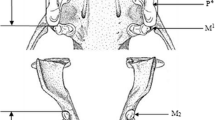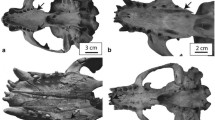Abstract
We examined dental anomalies, including oligodonty, polydonty, connation, rotation, and misalignment in 510 gray foxes and 150 red foxes from southern Illinois (USA). Dental anomalies were significantly more common (x 2 = 11.5, df = 1,p < 0.001) in gray foxes (n = 177; 34.7% of sample) than red foxes (n = 25; 16.6% of sample), and more common in male than female gray foxes (x 2 = 3.88, df = 1,p < 0.05). Polydonty was very uncommon, as expected for species in which the normal dental complement is close to the primitive eutherian number. In both species, the most prevalent anomaly was loss of the last lower molar. Loss of the upper or lower first premolar was also common. Thus, oligodonty almost always involved the smaller anterior (P1 and P1) or posterior (M3) teeth of the dental arcade. Conversely, the large carnassial teeth, with complex occlusal patterns and shearing surfaces, appeared to be highly conserved with only three anomalous individuals (0.4%) among all specimens.
Similar content being viewed by others
References
Bouwmeester J., Mulder J. L. and van Bree P. J. H. 1989. High incidence of malocclusion in an isolated population of the red fox (Vulpes vulpes) in the Netherlands. Journal of Zoology, London 219: 123–136.
Gingerich P. D. and Winkler D. A. 1979. Patterns of variation and correlation in the dentition of the red fox,Vulpes vulpes. Journal of Mammalogy 60: 691–704.
Grobler P. J., Taylor P. J., Pretorius M. D. and Anderson C. P. 1999. Fluctuating asymmetry and allozyme variability in the isolated springbokAnitdorcas marsupialis population from the Chelmsford Nature Reserve. Acta Theriologica 44: 183–193.
Hall E. R. 1940. Supernumerary and missing teeth in wild mammals of the orders Insectivora and Carnivora, with some notes on diesease. Journal of Dental Research 19: 103–143.
Miles A. E. W. and Grigson C. 1990. Colyer’s Variations and diseases of the teeth of animals. Cambridge University Press, New York: 1–672.
Pavlinov I. Y. 1975. Tooth anomalies in some Canidae. Acta Theriologica 20: 507–519.
Pengilly D. 1984. Developmental versus functional explanations for patterns of variability and correlation in the dentition of foxes. Journal of Mammalogy 65: 34–43.
Szuma E. 1999. Dental abnormalities in the red fox,Vulpes vulpes, from Poland. Acta Theriologica 44: 393–412.
Szuma E. 2002. Dental polymorphism in a population of the red fox (Vulpes vulpes) from Poland. Journal of Zoology, London 256: 243–253.
Vila C., Urios V. and Castroviejo J. 1993. Tooth losses and anomalies in the wolf (Canis lupus). Canadian Journal of Zoology 71: 968–971.
Author information
Authors and Affiliations
Corresponding author
Additional information
Associate Editor was Joseph F. Merritt.
Rights and permissions
About this article
Cite this article
Gisburne, T.J., Feldhamer, G.A. Dental anomalies in the gray foxUrocyon cinereoargenteus and the red foxVulpes vulpes . Acta Theriol 50, 515–520 (2005). https://doi.org/10.1007/BF03192644
Received:
Accepted:
Issue Date:
DOI: https://doi.org/10.1007/BF03192644




